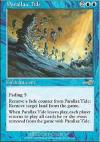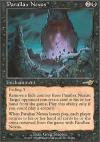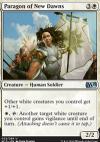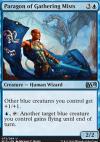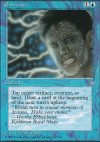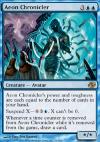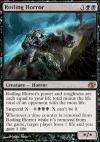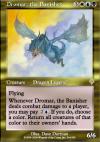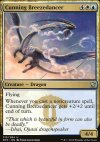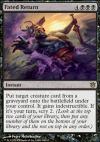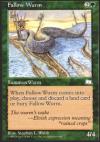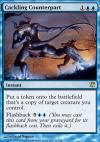|

MV anecdotes
| 951 anecdotes trouvées |   |
Les trois cartes Parallax Wave, Parallax Tide et Parallax Nexus, de l'édition Nemesis, forment un cycle appelé "Parallax".
La carte Parallax Inhibitor, de la même édition, est une référence à ce cycle de par son nom et son interaction avec les marqueurs "sursis".
Trois de ces cartes sont illustrées par Greg Staples.
La carte Parallax Inhibitor, de la même édition, est une référence à ce cycle de par son nom et son interaction avec les marqueurs "sursis".
Trois de ces cartes sont illustrées par Greg Staples.
Les cinq cartes Paragon of New Dawns, Paragon of Gathering Mists, Paragon of Open Graves, Paragon of Fierce Defiance et Paragon of Eternal Wilds, de l'édition Magic 2015, forment un cycle appelé "Paragon".
Les cinq cartes Archangel of Wrath, Vodalian Mindsinger, Stronghold Arena, Temporal Firestorm et Urborg Lhurgoyf, de l'édition Dominaria United, forment un cycle.
Les cinq cartes Emeria Shepherd, Guardian of Tazeem, Guul Draz Overseer, Akoum Hellkite et Oran-Rief Hydra, de l'édition Battle for Zendikar, forment un cycle.
Les cinq cartes Benalish Commander, Aeon Chronicler, Roiling Horror, Detritivore et Fungal Behemoth, de l'édition Planar Chaos, forment un cycle.
Les cinq cartes Treva, the Renewer, Dromar, the Banisher, Crosis, the Purger, Darigaaz, the Igniter et Rith, the Awakener, de l'édition Invasion, ainsi que les cinq cartes Oros, the Avenger, Intet, the Dreamer, Teneb, the Harvester, Numot, the Devastator et Vorosh, the Hunter, de l'édition Planar Chaos, forment un cycle de dragons.
Les deux cartes Hidden Dragonslayer et Silumgar Assassin, de l'édition Dragons of Tarkir, forment une paire.
Les cinq cartes Enduring Scalelord, Cunning Breezedancer, Ruthless Deathfang, Swift Warkite et Savage Ventmaw, de l'édition Dragons of Tarkir, forment un cycle de dragons bicolores peu communs soutenant chacun un archétype de formats limités.
Source 1 (CUNNING BREEZEDANCER AND FRIENDS) - Source 2 ("Draft, as an example, had a big influence on the uncommon gold cards that model Draft archetypes")
Source 1 (CUNNING BREEZEDANCER AND FRIENDS) - Source 2 ("Draft, as an example, had a big influence on the uncommon gold cards that model Draft archetypes")
Citation :
Erik Lauer, the head developer, came up with an idea several years back to use a cycle of two-color spells to help define color pairs in Limited. If you take the card early, it will help steer you to what the color combination is up to. [...] For Dragons of Tarkir, we asked, "What if the uncommon multicolor cycle was Dragons?" We wanted Dragons to be central to the gameplay, so why not use them on a component that was all about messaging?
These Dragons are a looser cycle. Each has an effect central to what its color pair is up to in Limited. The one thing they all have in common is they are all relatively strong in Limited and do a lot to help guide drafters.
These Dragons are a looser cycle. Each has an effect central to what its color pair is up to in Limited. The one thing they all have in common is they are all relatively strong in Limited and do a lot to help guide drafters.
Les cinq cartes Arashin Sovereign, Pristine Skywise, Necromaster Dragon, Boltwing Marauder et Harbinger of the Hunt, de l'édition Dragons of Tarkir, forment un cycle de dragons.
Source (Multicolor Rare Dragons - "This is another loose Dragon cycle. We wanted a rare cycle of two-color Dragons but we wanted them to each feel unique, so there's almost nothing tying this cycle together other than they are each one of the ally-colored pairs.")
Source (Multicolor Rare Dragons - "This is another loose Dragon cycle. We wanted a rare cycle of two-color Dragons but we wanted them to each feel unique, so there's almost nothing tying this cycle together other than they are each one of the ally-colored pairs.")
Les cinq cartes Anafenza, the Foremost, Narset, Enlightened Master, Sidisi, Brood Tyrant, Zurgo Helmsmasher et Surrak Dragonclaw, de l'édition Khans of Tarkir, forment un cycle de créatures légendaires tricolores, chacune représentant le khan de son clan.
Au moment des événements de l'édition Tarkir: Dragonstorm, les khans des clans sont respectivement Felothar, Dawn of the Abzan, Narset, Jeskai Waymaster, Kotis, the Fangkeeper, Zurgo, Thunder's Decree et Eshki Dragonclaw ; les anciens khans Anafenza, Unyielding Lineage, Sidisi, Regent of the Mire et Surrak, Elusive Hunter ont une autre occupation au sein du clan.
Source 1 (Prose and Khans) - Source 2 (Defined clans - "Once we had five clans, we had to have a more balanced structure to match the color pie. Shards of Alara focused on three-color shards (a color and its two allies), but we'd never done a wedge-focused set (a color and its two enemies).") - Source 3 (Use of Multicolor - Legendary Wedge Creatures (Mythic Rare) - "[...] The set needs mythic rare warlords, and the clans are each three colors. This cycle of mythic rare legendary creatures was a no-brainer. [...] These were the leaders of each clan.")
Au moment des événements de l'édition Tarkir: Dragonstorm, les khans des clans sont respectivement Felothar, Dawn of the Abzan, Narset, Jeskai Waymaster, Kotis, the Fangkeeper, Zurgo, Thunder's Decree et Eshki Dragonclaw ; les anciens khans Anafenza, Unyielding Lineage, Sidisi, Regent of the Mire et Surrak, Elusive Hunter ont une autre occupation au sein du clan.
Source 1 (Prose and Khans) - Source 2 (Defined clans - "Once we had five clans, we had to have a more balanced structure to match the color pie. Shards of Alara focused on three-color shards (a color and its two allies), but we'd never done a wedge-focused set (a color and its two enemies).") - Source 3 (Use of Multicolor - Legendary Wedge Creatures (Mythic Rare) - "[...] The set needs mythic rare warlords, and the clans are each three colors. This cycle of mythic rare legendary creatures was a no-brainer. [...] These were the leaders of each clan.")
Source 1 a écrit :
The design worked as such: each clan was centered in a color and had one ally color and one enemy color, resulting in a tri-color wedge combination. Each clan was also tied to an attribute of the dragon, which the clan tried to emulate. Here's the breakdown:
Abzan
• WBG (centered in white)
• Dragon Attribute: Endurance
• Symbol: Scale of the Dragon
• Khan: Anafenza
Jeskai
• URW (centered in blue)
• Dragon Attribute: Cunning
• Symbol: Eye of the Dragon
• Khan: Narset
Sultai
• BGU (centered in black)
• Dragon Attribute: Ruthlessness
• Symbol: Fang of the Dragon
• Khan: Sidisi
Mardu
• RWB (centered in red)
• Dragon Attribute: Speed
• Symbol: Wing of the Dragon
• Khan: Zurgo
Temur
• GUR (centered in green)
• Dragon Attribute: Savagery
• Symbol: Claw of the Dragon
• Khan: Surrak
Abzan
• WBG (centered in white)
• Dragon Attribute: Endurance
• Symbol: Scale of the Dragon
• Khan: Anafenza
Jeskai
• URW (centered in blue)
• Dragon Attribute: Cunning
• Symbol: Eye of the Dragon
• Khan: Narset
Sultai
• BGU (centered in black)
• Dragon Attribute: Ruthlessness
• Symbol: Fang of the Dragon
• Khan: Sidisi
Mardu
• RWB (centered in red)
• Dragon Attribute: Speed
• Symbol: Wing of the Dragon
• Khan: Zurgo
Temur
• GUR (centered in green)
• Dragon Attribute: Savagery
• Symbol: Claw of the Dragon
• Khan: Surrak
Les cinq cartes Abzan Guide, Efreet Weaponmaster, Abomination of Gudul, Ponyback Brigade et Snowhorn Rider, de l'édition Khans of Tarkir, forment un cycle.
Source (Use of Multicolor - Three-Color Morph (Uncommon) - "We wanted each clan to have a morph creature that was in all three colors. Each tries to play into the theme and play pattern of its clan. These creatures are all currently {2}{C}{D}{F}, both in mana cost and morph cost.")
Source (Use of Multicolor - Three-Color Morph (Uncommon) - "We wanted each clan to have a morph creature that was in all three colors. Each tries to play into the theme and play pattern of its clan. These creatures are all currently {2}{C}{D}{F}, both in mana cost and morph cost.")
Les cinq cartes Fated Retribution, Fated Infatuation, Fated Return, Fated Conflagration et Fated Intervention, de l'édition Born of the Gods, forment un cycle appelé "Fated -".
Les quatre cartes Air Elemental, Water Elemental, Earth Elemental et Fire Elemental, de l'édition Limited (Alpha), forment un cycle qui fait référence aux quatre éléments.
Les deux cartes Fallow Wurm et Harvest Wurm, de l'édition Weatherlight et illustrées par Stephen L. Walsh, forment une paire ; à noter que le défaut de l'une (contrebalançant ses force et endurance élevées par rapport à son coût de mana) permet de neutraliser celui de l'autre. De plus leurs textes d'ambiance se font écho.
Les deux cartes Daraja Griffin et Unyaro Griffin forment une paire de "Color-Hosers", chaque créature pouvant se sacrifier pour gérer l'une des couleurs ennemies du blanc, respectivement le noir et le rouge.
Les cinq cartes Divine Reckoning, Cackling Counterpart, Sever the Bloodline, Devil's Play et Creeping Renaissance, de l'édition Innistrad, forment un cycle d'éphémères/rituels avec un coût de Flashback élevé.
Les cinq cartes White Plume Adventurer, Tomb of Horrors Adventurer, Ravenloft Adventurer, Caves of Chaos Adventurer et Undermountain Adventurer, de l'édition Commander Legends: Battle for Baldur's Gate, forment un cycle appelé "Adventurer".
Les deux cartes Phalanx Formation et Aerial Formation, de l'édition Journey into Nyx, forment une paire.
Les deux cartes Witty Roastmaster et Social Climber, de l'édition Streets of New Capenna, forment une paire.
Les dix cartes Gates of Istfell, Port of Karfell, Immersturm Skullcairn, Gnottvold Slumbermound, Bretagard Stronghold, Great Hall of Starnheim, Surtland Frostpyre, Skemfar Elderhall, Axgard Armory et Littjara Mirrorlake, de l'édition Kaldheim, forment un cycle de terrains.
Les cinq cartes Jubilant Skybonder, Cunning Nightbonder, Sonorous Howlbonder, Proud Wildbonder et Alert Heedbonder, de l'édition Ikoria Lair of Behemoths, forment un cycle appelé "-bonder" de créatures bicolores avec un coût de mana comprenant deux manas hybrides de deux couleurs alliées.
Les cinq cartes Skycat Sovereign, Slitherwisp, Labyrinth Raptor, Quartzwood Crasher et Frondland Felidar, de cette même édition, forment un second cycle de créatures bicolores associées aux couleurs alliées. Les cartes qui partagent une couleur partagent aussi un type de créature associé à cette couleur : Cat,
Cat,  Elemental,
Elemental,  Nightmare,
Nightmare,  Dinosaur et
Dinosaur et  Beast.
Beast.
Les deux cycles se font écho par paires de couleurs alliées, chaque paire correspondant à une capacité mot-clé commune à ses couleurs selon la color pie ( /
/ Vol,
Vol,  /
/ Flash,
Flash,  /
/ Menace,
Menace,  /
/ Piétinement et
Piétinement et  /
/ Vigilance) et chaque créature renforçant l'effet de cette capacité mot-clé.
Vigilance) et chaque créature renforçant l'effet de cette capacité mot-clé.
Les cinq cartes Skycat Sovereign, Slitherwisp, Labyrinth Raptor, Quartzwood Crasher et Frondland Felidar, de cette même édition, forment un second cycle de créatures bicolores associées aux couleurs alliées. Les cartes qui partagent une couleur partagent aussi un type de créature associé à cette couleur :
 Cat,
Cat,  Elemental,
Elemental,  Nightmare,
Nightmare,  Dinosaur et
Dinosaur et  Beast.
Beast.Les deux cycles se font écho par paires de couleurs alliées, chaque paire correspondant à une capacité mot-clé commune à ses couleurs selon la color pie (
 /
/ Vol,
Vol,  /
/ Flash,
Flash,  /
/ Menace,
Menace,  /
/ Piétinement et
Piétinement et  /
/ Vigilance) et chaque créature renforçant l'effet de cette capacité mot-clé.
Vigilance) et chaque créature renforçant l'effet de cette capacité mot-clé.Les cinq cartes Healer's Headdress, Neurok Stealthsuit, Cranial Plating, Sparring Collar et Horned Helm, de l'édition Fifth Dawn, forment un cycle.
| 951 anecdotes trouvées |   |






 Tarkir: Dragonstorm
Tarkir: Dragonstorm Aetherdrift
Aetherdrift Foundations
Foundations Duskmourn
Duskmourn Bloomburrow
Bloomburrow Modern Horizons III
Modern Horizons III Outlaws of Thunder Junction
Outlaws of Thunder Junction
